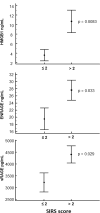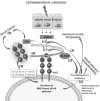Circulating levels of soluble receptor for advanced glycation end products and ligands of the receptor for advanced glycation end products in patients with acute liver failure
- PMID: 25825217
- PMCID: PMC4933521
- DOI: 10.1002/lt.24129
Circulating levels of soluble receptor for advanced glycation end products and ligands of the receptor for advanced glycation end products in patients with acute liver failure
Abstract
Animal studies suggest that receptor for advanced glycation end products (RAGE)-dependent mechanisms contribute to acetaminophen-induced liver damage. We examined whether circulating levels of soluble receptor for advanced glycation end products (sRAGE) or RAGE ligands, including extracellular newly identified receptor for advanced glycation end products binding protein (EN-RAGE), high-mobility group box 1 (HMGB1), and Nε-(Carboxymethyl)lysine adducts (CML), could aid in prognostication after an acetaminophen overdose. Sixty well-characterized acetaminophen-related acute liver failure (ALF) patients (30 spontaneous survivors and 30 patients who underwent transplantation and/or died) who were enrolled in the National Institutes of Health-sponsored Acute Liver Failure Study Group, were matched by age, met standard criteria for encephalopathy, and had an international normalized ratio > 1.5 were retrospectively studied. HMGB1, EN-RAGE, CML, and sRAGE were detected by enzyme-linked immunosorbent assay methods in sera from ALF patients and 30 healthy controls. Levels of sRAGE, EN-RAGE, and HMGB1 (but not CML) were significantly greater (P < 0.001) in ALF patients versus normal controls. The levels of sRAGE, HMGB1, and EN-RAGE were significantly higher (P = 0.03, P < 0.01, and P = 0.03) in patients with a systemic inflammatory response syndrome (SIRS) score > 2 versus patients with a SIRS score ≤ 2. Nevertheless, only sRAGE levels were significantly higher in patients who underwent transplantation and/or died versus spontaneous survivors (P < 0.001), and they were positively associated with conventional markers of liver disease severity. Multivariate logistic regression identified an encephalopathy grade > 2 as an independent predictor of an adverse outcome on admission (odds ratio, 13; 95% confidence interval, 2.3-73; P < 0.001). The RAGE-ligand axis may interfere with liver regeneration and should be a promising objective for further research.
© 2015 American Association for the Study of Liver Diseases.
Conflict of interest statement
The authors have no conflicts of interest to disclose.
Figures


References
-
- Vaquero J, Blei AT. Etiology and management of fulminant hepatic failure. Curr Gastroenterol Rep. 2003;5:39–47. - PubMed
-
- Larson AM, Polson J, Fontana RJ, Davern TJ, Lalani E, Hynan LS, et al. Acetaminophen-induced acute liver failure: results of a United States multicenter, prospective study. Hepatology. 2005;42:1364–1372. - PubMed
-
- Lee WM. Acetaminophen-related acute liver failure in the United States. Hepatol Res. 2008;38(Suppl 1):S3–8. - PubMed
-
- Lee WM. Acute liver failure in the United States. Semin Liver Dis. 2003;23:217–226. - PubMed
Publication types
MeSH terms
Substances
Grants and funding
LinkOut - more resources
Full Text Sources
Other Literature Sources
Medical
Research Materials
Miscellaneous
